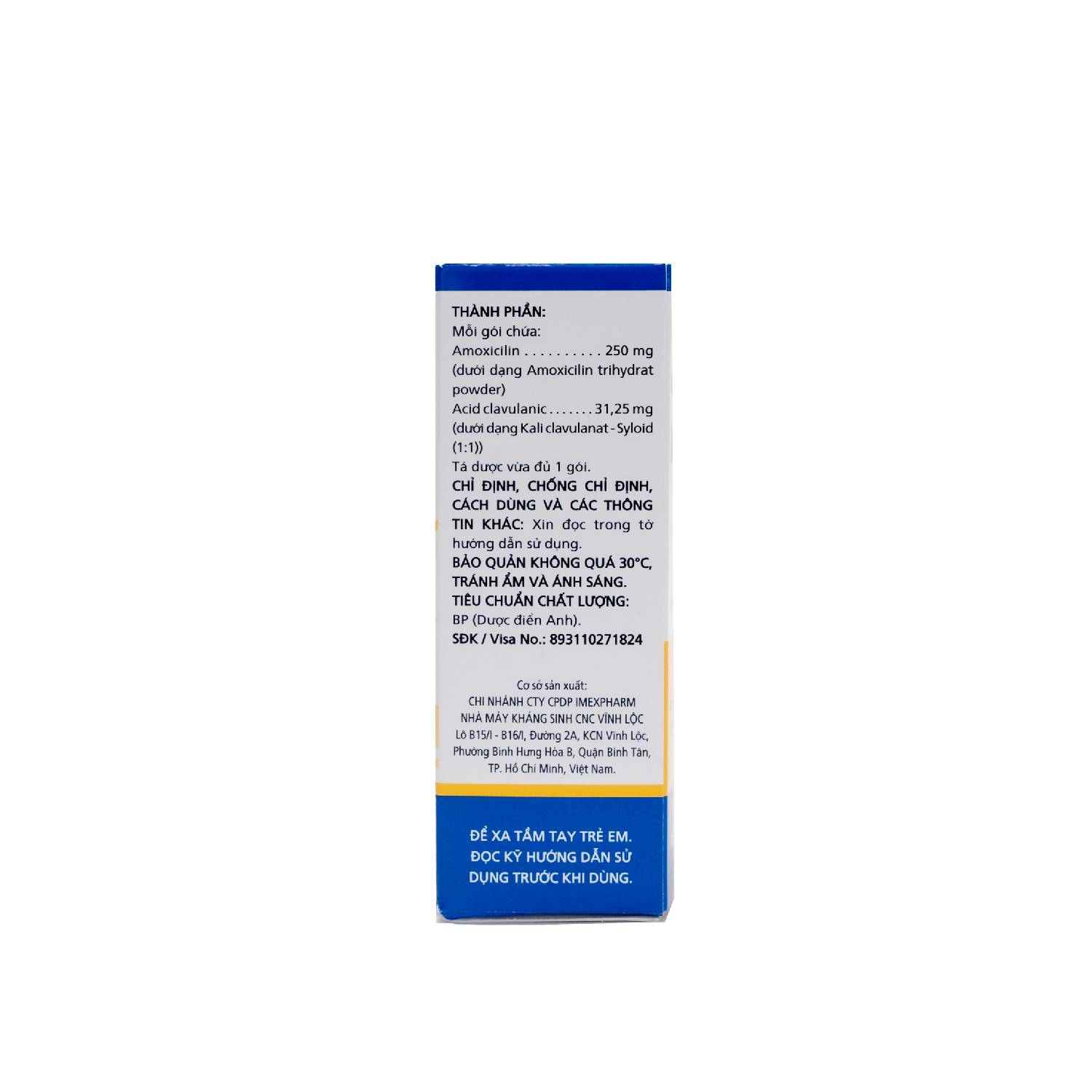




Amoxicillin/ Acid clavulanic 250 mg/ 31,25 mg
Manufacturer
Branch of Imexpharm Corporation - Vinh Loc Hi-Tech Pharmacetical Antibiotic Plant
Applicant company
Imexpharm Pharmaceutical Joint Stock Company
Active ingredient
Acid clavulanic (as Kali clavulanat - Syloid (1:1)); Amoxicilin (as Amoxicilin trihydrat powder)
Content
250 mg / 31,25 mg
Shelf life
24 months
Dosage Form
Powder for oral suspension
Package
Box of 1 bag x 12 sachets x 1 g
Visa Number
893110271824
Issuing Date
06/05/2024
Therapeutic area
Antibiotics
Indication
Amoxicillin/Clavulanic Acid 250 mg/31.25 mg should be used in accordance with antibiotic prescribing guidelines and local bacterial sensitivity data.
Amoxicillin/Clavulanic Acid 250 mg/31.25 mg is indicated for the short-term treatment of infections caused by amoxicillin/clavulanic acid-sensitive bacteria at the following sites:
- Upper respiratory tract infections (including ENT infections) such as recurrent tonsillitis, sinusitis, otitis media, typically caused by Streptococcus pneumoniae, Haemophilus influenzae¹, Moraxella catarrhalis¹, and Streptococcus pyogenes.
- Lower respiratory tract infections such as acute exacerbations of chronic bronchitis, lobar pneumonia, and bronchopneumonia, typically caused by Streptococcus pneumoniae, Haemophilus influenzae¹, and Moraxella catarrhalis¹.
- Genitourinary tract infections such as cystitis, urethritis, pyelonephritis, and female genital tract infections, typically caused by Enterobacteriaceae¹ (mainly Escherichia coli¹), Staphylococcus saprophyticus, Enterococcus spp., and gonorrhea caused by Neisseria gonorrhoeae¹.
- Skin and soft tissue infections, typically caused by Staphylococcus aureus¹, Streptococcus pyogenes, and Bacteroides spp¹.
- Bone and joint infections, such as osteomyelitis, typically caused by Staphylococcus aureus¹, usually requiring prolonged treatment.
- Other infections, such as infected miscarriage, postpartum infections, and intra-abdominal infections.
¹Some bacterial strains of these species produce beta-lactamase enzymes, rendering them resistant to amoxicillin when used alone (see section on Pharmacodynamic Properties).
Bacterial susceptibility to Amoxicillin/Clavulanic Acid 250 mg / 31.25 mg may vary according to geographical location and over time. Local epidemiological data on antimicrobial susceptibility should be consulted where available, and susceptibility testing should be performed when clinically indicated.
Mixed infections caused by amoxicillin-susceptible strains in conjunction with beta-lactamase-producing organisms susceptible to amoxicillin/clavulanic acid may be appropriately treated with this formulation.
Dosage
Dosage is adjusted according to severity of infection, age, weight and renal function of the patient.
Doses are expressed in terms of amoxicillin/clavulanic acid unless otherwise stated in terms of individual components.
Duration of treatment should be adjusted according to patient response. Some infections (e.g. osteomyelitis) require longer durations of treatment. Treatment should not be continued beyond 14 days without reassessment of the patient's condition.
Adults:
| Infection | Dosage |
|---|---|
| Mild to moderate infections | 1000 mg amoxicilin/ 125 mg acid clavulanic/ time x 2 time per day (equivalent to 4 sachets/ time x 2 times/ day) |
| Severe infections (including recurrent and chronic urinary tract infections, lower respiratory tract infections) | 1000 mg amoxicilin/ 125 mg acid clavulanic/ time x 3 times per day (equivalent to 4 sachets/ time x 3 times/ day) |
- Children weighing 40 kg or more: Use the same dosage as adults.
- Children under 12 years of age and/or weighing less than 40 kg:
+ Recommended dose: 40 mg amoxicillin/5 mg clavulanic acid/kg/day to 80 mg amoxicillin/10 mg clavulanic acid/kg/day (not to exceed 3000 mg amoxicillin/375 mg clavulanic acid/day), divided into 3 times/day, depending on the severity of the infection.
+ Or the recommended dose is calculated by sachet:
| Weighing | Dosage per sachet |
|---|---|
| 10 kg to under 20 kg | 1 sachet/ time x 3 times/ day |
| 20 kg to under 30 kg | 2 sachets/ time x 3 times/ day |
| 30 kg to under 40 kg | 2-3 sachets/ time x 3 times/ day |
Elderly:
No dosage adjustment is required. Use the same dosage as for adults. If there are signs of renal impairment, the dosage should be adjusted according to creatinine clearance (CrCl)
Patients with renal impairment:
| Creatinine clearance (CrCl) | Dosage |
|---|---|
| ≥ 30 mL/min | No dosage adjustment is required. |
| < 30 mL/min | The combination of amoxicillin/clavulanic acid at a ratio of 8/1 is not recommended because there is no dosage adjustment recommendation. |
Patients with hepatic impairment: Use with caution and periodically check liver function during the use of the drug.
Contact





